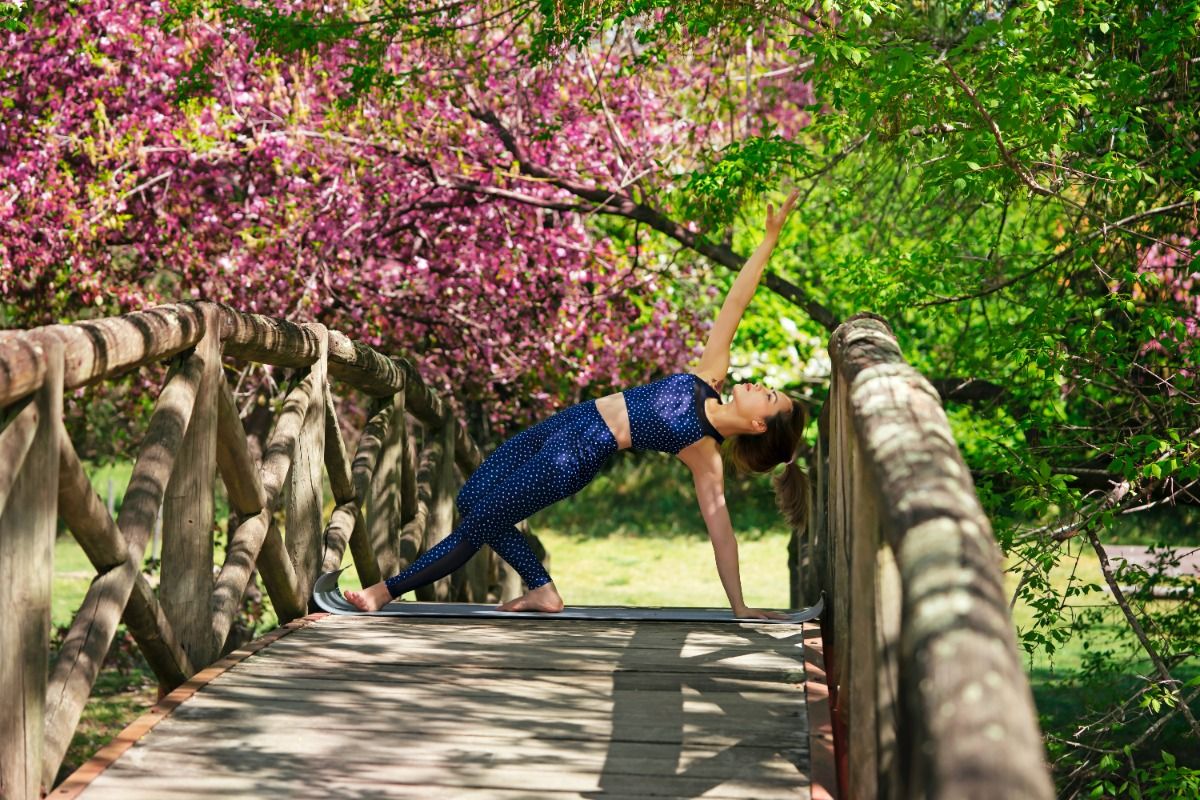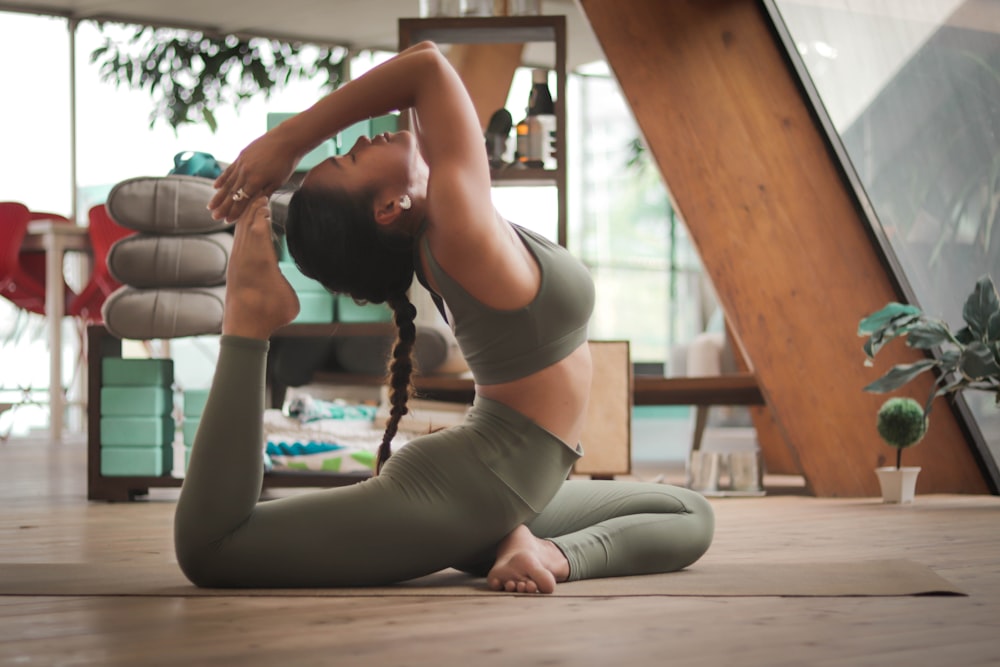
Which types of yoga are best suited for you, and which type of yoga should you start with? The answer depends on your current fitness level and your overall goals. There are many different types of yoga, each with its own distinct health benefits.
The type of yoga you start with depends on what you hope to gain from yoga. Certain types of yoga are more meditative, relaxing and stress-reducing. Other types of yoga are more of a calorie-burning workout, and yoga can definitely tone your body. Still, other types of yoga are good for improving flexibility and mobility.
Yoga is a low-impact form of exercise, widely regarded as safe, beneficial, and excellent for improving health and wellness. However, some types of yoga will suit your specific health goals more than others.
Although all the main types of yoga can have shared benefits such as lowered blood pressure and increased strength, some types of yoga have distinct advantages for certain people.
Hatha and Vinyasa yoga is ideal for improving flexibility, which can be crucial for anyone starting yoga for the first time. Alternatively, Ashtanga yoga might be best for managing anxiety and depression.
If you want to join the 300 million other people embracing the benefits of yoga worldwide, below is an insider’s look at which type of yoga might be best for you.
Common Health Benefits of Yoga
There are dozens of different types of yoga, and many of them share a series of positive advantages for your body, mental health, and state of mind. All styles of yoga can create a sense of relaxation and peace, and many will help with common health problems such as muscle pain or trouble sleeping.
Below are some of the common health benefits of yoga:
- Improved muscle tone and strength
- Reduced stress and anxiety
- Improved flexibility
- Weight loss
- Improved cardiovascular and circulatory health
- Increased energy levels
- Reduced risk of injuries
- Improved posture
- Reduced back pain
- Endorphins to improve your mood

Different Types of Yoga and Their Individual Health Benefits
Learning about the types of yoga can help you make an informed decision instead of arbitrarily signing up for a random yoga class.
An asana is a specific yoga position. It’s always worth trying a few simple yoga poses (asanas) to see how they feel. This will help you figure out which type of yoga is best for you to start with. Trying a few asanas will also give you an idea of whether you should try an easier or more challenging type of yoga to start with.
If you’re already very flexible, and you want to use yoga as a calorie-burning workout, you might start with a more advanced type of yoga such as power yoga or Bikram yoga.
If your primary goal is relaxation and mental health benefits rather than physical fitness benefits, you might try a gentler yoga to start with such as “Hatha” yoga.
Let’s take a closer look at the different types of yoga and their respective health benefits, so you can figure out which type of yoga to start with based on your goals:
1. Vinyasa Yoga (Flow Yoga)
Vinyasa yoga, also known as “flow yoga”, is sometimes more challenging and referred to as “power yoga”. Vinyasa is all about linking poses together in a flow of constant movement. One of the more contemporary types of yoga, Vinyasa teachers will string complementary asanas together to help improve the balance and movement of your body.
In vinyasa yoga, all movements are synchronized to your breath. While Vinyasa yoga may feel a little fast-paced or complicated for beginners, there are a lot of simple movements you can try to get started. For instance, the cat-cow stretch is a great example of a simple Vinyasa pose.
When the term “Vinyasa” is used as a noun, it can also apply to a specific series of three poses done as part of the sun salutation sequence. For beginners, the salutation would look something like this:
- Start in a plank position
- Lower your knees, chest, and chin to the mat as you exhale
- Inhale and slide forward to a low cobra pose with your pelvis on the floor
- Exhale and curl your toes as you straighten your arms and legs, pushing into downward dog
The most common benefits of vinyasa yoga include toning your body, and improved stability, balance, and endurance. Because the challenging poses of this yoga are completed in quick succession, they also help to build muscle strength too.
2. Hatha Yoga
Hatha Yoga is probably the most common form of yoga because it applies to all of the “physical poses” you do to stretch and make shapes with your body. In the West, Hatha yoga will refer to multiple different styles of yoga, including Ashtanga and Iyengar. There are other kinds of yoga that focus on mental health and growth too.
Hatha yoga is usually a little different to Vinyasa yoga because there’s a small gap between each pose. You might start with a downward facing dog, then move back into a comfortable position, and continue with a cow pose.
The benefits of Hatha yoga are the benefits of any kind of physical yoga, including improved endurance, balance, and posture. Certain types of poses also have individual health benefits. For instance, Downward facing dog helps to balance your body and stretch the upper and lower parts of your body. To perform downward-facing dog:
- Sit on the floor and place your arms in front of you, with your hands against the ground
- Lift your bum away from the floor and up into the air, stretching your legs to push yourself up
- Push up with your hands to lift the upper part of your body, so you make a un upside-down V shape
3. Iyengar Yoga
Iyengar yoga is a type of yoga focused on alignment and precise movements. One of the most accessible forms of yoga in the world, Iyengar yoga is focused on making sure you’re moving and using your body correctly, often through slower movements.
Created by B.K.S Iyengar in the 1960s, Iyengar yoga can build strength because it requires you to hold a pose for a specific period of time. This type of yoga also increases flexibility, boosts energy levels and decreases stress and anxiety. Iyengar can also reduce chronic pain because discomfort is often a result of bad alignment.
A popular form of Iyengar yoga is the tree pose, which focuses heavily on balance. With the tree pose, you stand straight up, hold your hands together and rest one foot against one knee. The aim is to hold the pose without wobbling.
4. Kundalini Yoga
While most people think of yoga as a physical practice, it can also be a tool for mental enlightenment too. Kundalini yoga is equal parts physical and spiritual. This style of yoga revolves around the idea that you have energy trapped in your body (around the lower spine).
There are a number of science-backed benefits to practising Kundalini yoga. Research has found it can help to reduce stress and anxiety, as well as improving cognitive function. However, because this kind of yoga focuses heavily on the core of the body, it may not be suitable for everyone. Pregnant people and those with lung conditions may struggle.
One popular form of Kundalini yoga is the “breath of fire”. Considered to be a detoxifying process that oxygenates the blood and uses the diaphragmatic breathing technique, the breath of fire involves:
- Inhaling deeply, while pushing your stomach outwards
- Exhaling and pulling your stomach into your spine

5. Ashtanga Yoga
Ashtanga yoga is focused heavily on flexibility and movement. This type of yoga may be less appealing to beginners, as it requires more complex poses. If you’re comfortable with putting your body to the test, Ashtanga can have a lot of benefits, including gradually improving your flexibility over time.
Ashtanga yoga is similar to Vinyasa yoga, as it involves moving rapidly from one pose to the next in quick succession. The challenge of moving through poses is great for improving muscle tone, and strength. It can also be an excellent way to improve cardiovascular fitness and minimize feelings of stress and anxiety.
An Ashtanga yoga routine will involve a series of different motions, intended to address various body parts. Try this video for an insight into a 30-minute flow.
6. Bikram Yoga (Hot Yoga)
Bikram yoga is a very intense workout and a great choice if you have physical fitness goals such as weight loss. Otherwise known as “hot yoga”, Bikram Yoga is named after Bikram Choudhury. Similar to Ashtanga and Vinyasa yoga, Bikram involves a series of movements one after another. The main difference between this and other types of yoga is that your poses are performed in a room heated to around 105 degrees, with 40% humidity.
The name “Bikram yoga” has mostly been phased out following criminal allegations about the founder, but hot yoga is still a popular practice with a lot of health benefits.
Hot yoga is one of the best forms of yoga if you want to burn calories and tone your body. Hot yoga can also reduce blood glucose levels, improve cardiovascular performance, and reduce stress.
7. Yin Yoga
If you’re not sure about your flexibility levels and you don’t feel comfortable challenging your body too much straight away, Yin Yoga may be the best choice for you. This slow-paced style of yoga is excellent for older people or those with injuries. Yin yoga is a kind of meditative yoga, which involves a lot of sitting postures, and posture holding.
Regularly recommended for rehabilitation after injury, or stretching after a long day at a desk. Yin Yoga is all about getting to know your body. Most classes are relaxed, as you can allow gravity to do much of the work for you. One great pose is the butterfly pose:
- Sit on the ground and place the soles of your feet together
- Push your feet gradually way from you, creating space between your heels and pelvis
- Fold forward gently, allowing your spine to curve
- Drop your head towards your feet, and rest your elbows on the floor
- You can place your head in your hands for balance
Which Type of Yoga is Best For You?
Remember that each type of yoga has individual health benefits, and you are now aware of which type of yoga might suit your specific goals.
For beginners, however, a simple and gentle yoga such as Hatha yoga or Yin yoga will often be the best choice. If you decide you want to start losing some weight and improve your strength, you can consider Vinyasa yoga or Bikram yoga instead.
If you’re interested in learning more about your optimal workout routine, get your comprehensive health report from CircleDNA. This DNA test provides you with 500 reports in over 20 categories, including a report on your optimal fitness routine based on your DNA.
